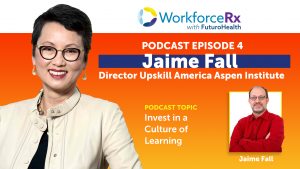The old way of managing a workplace was relentless, and the message was clear: Work comes above all else.
That approach has been slowly changing over the years, and was drastically rewritten during the COVID-19 pandemic. As companies were forced to allow employees to work from home and to take personal time when they and their families were impacted by sickness, it became clear that there was no turning back to the era of unrealistic demands.
Whether we were ready for it or not, personal life has become inextricably tied to work life.
 Jaime Fall, Director of the UpSkill America initiative at The Aspen Institute, has worked in the field of workforce development for nearly 25 years. Despite current challenges, he says employers can balance employees’ personal needs with the demand for forward-thinking skills to meet their business goals.
Jaime Fall, Director of the UpSkill America initiative at The Aspen Institute, has worked in the field of workforce development for nearly 25 years. Despite current challenges, he says employers can balance employees’ personal needs with the demand for forward-thinking skills to meet their business goals.
On an episode of the WorkforceRx podcast, I had the pleasure of chatting with Jaime about what’s currently happening in the world of work, specifically how employers are — and should be — supporting staff personal development, including education.
Insulate and energize your staff with educational investments
Jaime now leads an employer-led movement to expand opportunity for America’s workers, but he has direct personal experience with workforce development. When he worked as a janitor at a radio station, the station paid for two years of his college education.
This early show of support propelled him from entry-level manual labor into communications and marketing, and eventually, workforce development and policy: a trajectory he probably wouldn’t have taken had it not been for that employer’s investment in his career growth.
That radio station likely wasn’t under any illusion that Jaime would work there forever, but they still invested in his knowledge base. Why?
Smart employers know that people are their best investments.
And when people are struggling — as frontline workers have through the COVID pandemic — work becomes compromised. Their stresses trickle upwards and bleed into management. Thus, businesses where employees aren’t happy and secure at home face lower productivity and, ultimately, poorer returns.
“All these things going on with us personally can affect our performance at work under certain conditions,” says Jaime.
Performance is important, but it’s the proverbial icing on the cake when you can’t get people to show up in the first place. Especially with the labor shortage that began in late 2020, employees needed incentives to stay loyal to a given employer through their period of hardship.
The companies that are deliberately choosing not to cut career-building education and training programs aren’t just treating people with dignity — they are contributing to higher long-term staff retention rates. Need proof? A 2021 survey by Quantum Workplace showed that a lack of career development opportunities is a major reason employees leave.
Some organizations are also using the money they’re saving on overhead to subsidize wellness programs and technology for more comfortable at-home offices, further demonstrating how much they value a comfortable and healthy work environment.
It’s unfortunate that it took a global crisis to get greater numbers of businesses to acknowledge the impact of workers’ personal circumstances. But companies that are doing so in addition to investing in programs that enhance skills like digital literacy are riding the workforce wave into the future.
Why tuition reimbursement isn’t enough

Standard practice for educating or retraining employees used to be a tuition reimbursement plan. However, Jaime points out that this approach is outdated and only serves to limit accessibility to populations who faced existing inequities before the pandemic.
Often, only the highest-paid employees can afford to dip into their own pockets to go back to school. Thus, tuition reimbursement is not an enticing benefit for all.
Instead, continuing education and skills training should be available to those in every income tier. It’s better for your business when everyone rises together.
“We hear from employers all the time that the pace of change continues to accelerate,” says Jaime. “If that’s true, they’re going to continue to need their employees learning.”
Jaime shares best practices for employers that want alternative incentives to the traditional reimbursement option:
- Reduce training program eligibility requirements to expand participation.
- Offer access to training early on (shortly after hiring) to show new employees they’re valued and encourage retention.
- Partner with intermediaries and education providers in your industry to offer a variety of affordable in-person and online programs.
Make career growth a clear priority

Of course, good jobs should await people post-training.
Rather than sending your employees off in different directions to learn disjointed skills, which could ultimately encourage them to find somewhere else to work, integrate ways for them to put those new skills to use in your evolving organization.
“It’s important for companies to invest in a culture of learning,” Jaime concludes.
That much is clear — especially so in an uncertain climate, which is why “WorkforceRx: Agile and Inclusive Strategies for Employers, Educators and Workers in Unsettled Times” offers a collection of proven workforce development strategies refined for the private, public, education, and nonprofit sectors. And for more on how to use upskilling to carry your workforce into the future, check out the “UpSkilling Playbook for Employers.”



